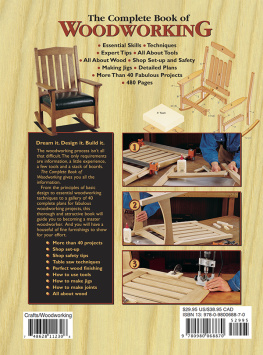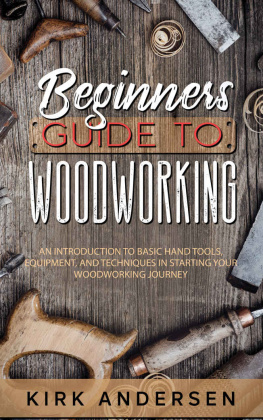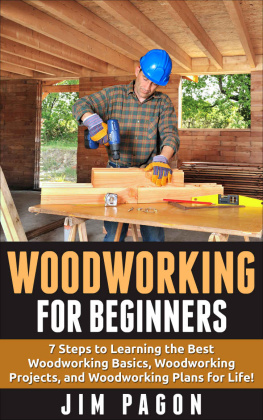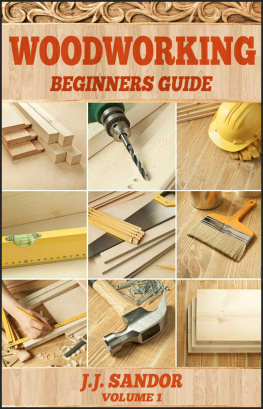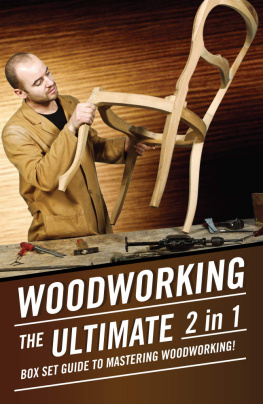Karl Winkler - Woodworking: Workshop Design and Helpful Tips for Beginners
Here you can read online Karl Winkler - Woodworking: Workshop Design and Helpful Tips for Beginners full text of the book (entire story) in english for free. Download pdf and epub, get meaning, cover and reviews about this ebook. year: 2020, genre: Home and family. Description of the work, (preface) as well as reviews are available. Best literature library LitArk.com created for fans of good reading and offers a wide selection of genres:
Romance novel
Science fiction
Adventure
Detective
Science
History
Home and family
Prose
Art
Politics
Computer
Non-fiction
Religion
Business
Children
Humor
Choose a favorite category and find really read worthwhile books. Enjoy immersion in the world of imagination, feel the emotions of the characters or learn something new for yourself, make an fascinating discovery.

- Book:Woodworking: Workshop Design and Helpful Tips for Beginners
- Author:
- Genre:
- Year:2020
- Rating:3 / 5
- Favourites:Add to favourites
- Your mark:
- 60
- 1
- 2
- 3
- 4
- 5
Woodworking: Workshop Design and Helpful Tips for Beginners: summary, description and annotation
We offer to read an annotation, description, summary or preface (depends on what the author of the book "Woodworking: Workshop Design and Helpful Tips for Beginners" wrote himself). If you haven't found the necessary information about the book — write in the comments, we will try to find it.
Karl Winkler: author's other books
Who wrote Woodworking: Workshop Design and Helpful Tips for Beginners? Find out the surname, the name of the author of the book and a list of all author's works by series.
Woodworking: Workshop Design and Helpful Tips for Beginners — read online for free the complete book (whole text) full work
Below is the text of the book, divided by pages. System saving the place of the last page read, allows you to conveniently read the book "Woodworking: Workshop Design and Helpful Tips for Beginners" online for free, without having to search again every time where you left off. Put a bookmark, and you can go to the page where you finished reading at any time.
Font size:
Interval:
Bookmark:
Woodworking
Workshop Design and Helpful Tips for Beginners
2 Books in 1
Karl Winkler
Copyright
All rights reserved.
No part of this book may be reproduced in any form or by any electronic, print or mechanical means, including information storage and retrieval systems, without permission in writing from the publisher.
Copyright 2020 Karl Winkler
Disclaimer
Purchasing this book can be seen as consent to the fact that both the publisher and the author of this book are in no way experts on the topics discussed within. This book is advanced with the objective of providing information that is as accurate and reliable as possible. Under no circumstances will any legal responsibility or blame be held against the publisher for any reparation, damages, or monetary loss due to the information herein, either directly or indirectly. This declaration is deemed fair and valid by both the American Bar Association and the Committee of Publishers Association and is legally binding throughout the United States. There are no scenarios in which the publisher or the original author of this work can be in any fashion deemed liable for any hardship or damages that may befall the reader or anyone else after undertaking information described herein. The information in the following pages is intended only for informational purposes. As befitting its nature, it is presented without assurance regarding its prolonged validity or interim quality. Trademarks that are mentioned are done without written consent and can in no way be considered an endorsement from the trademark holder.
Table of Contents Book 1
Table of Contents Book 2
Since workspaces vary so widelyfrom cavernous lofts in industrial buildings to the curves of basements and garages, down to hallways and closets - its hard to make definitive statements about shop layout. Just like having a workspace that is too hot, too cold, or too dark, a disorganized floor plan means woodworking wont be as much fun. With too much fussing between every task, your frustration level will mount. Ever wonder why you are hesitating to head out to the shop? If its not plain laziness, it might be one of the culprits listed above. I cant help with chronic lassitude, but I can give some advice on shop layout, with help from a few of my friends. While shop spaces range widely, most of us end up with a similar set of tools. Most also need some storage space for lumber, power tools, and other supplies; a router-table solution; and at least one other waist-high work exterior, aside from the workbench. In all cases the tablesaw and workbench were placed first, since they are used the most and require the most elbow room. But after that, these guys came up with a diversity of smart layout solutions. Also, space needs vary for hobbyists vs. professionals. Thats because time is money for the latter. The rest of us can live with a bit of shuffling to make things work. If you select to work with hand tools only, several of these rules dont apply. Even if you make exclusions for a jointer and bandsaw to speed things up, youll be able to work comfortably in much less space, with only a workbench and tool cabinet to accommodate.
Book 1 begins with some workshop tips for basements and design tips for garage conversion. Then we are going to look at small workshop options, low-cost workshop options, how to wire your workshop, and tips for light improvements. Next, you will learn plenty of tips and techniques for Workbenches and storages, dust collectors, bench vises, sawhorses, cabinet installations, wall storages and how to build a wall cabinet. After that, you will learn woodworking safety practices, tips for dust protection, dust mask and respirators usage. Lastly, you will comprehend how to start planning your ventures and how to develop your own designs.
Book 2 begins with tips and techniques on how to shape wood, how to use bandsaw, Jigsaw and a handplane like a pro. Next, you will learn how to smooth wood, ripping techniques, how to apply crosscuts, how to break edges, and how to taper legs using tablesaw. Moving on, you will comprehend wood moulding techniques, how to fix mistakes, joinery and miter Joint tips. After that, we will cover how to cut mortises, how to fit tenons using handplanes, and additional mortise and tenon joinery techniques. Next, you will learn how to work with curves, how to peg wood joints, how to layout dovetails, and how to use Dovetails on the tablesaw. Lastly, you will comprehend how to miter your dovetails and how to implement moulded joints.
Book 1
Woodworking for Beginners
How to design your first Workshop
by
Karl Winkler
A basement is a hole in the ground and attracts all manner of moisture, with questions such as mildew, rust, even small floods. Underground rooms arent flooded with natural sunlight, either; single incandescent fixtures are the norm, typically scattered where you dont require them. Additionally, basements are where household items go to die, so space is tight. Still, for lack of an alternative, numerous woodworkers set up shop in the basement and have to deal with any or all these dreads. To help them out, we asked our experienced friends for tips on making a basement workshop drier, brighter, and more space-efficient. We also asked folks how they prevent noise and dust from infiltrating the living areas above. The reaction was overpowering, and we got plenty of nifty solutions to common issues. We used those thoughts to create a virtual basement shop that is as comfortable to work in as it is inconspicuous to the rest of the household.
Basement walls are concrete, a absorbent material that allows moisture penetration if you dont take measures to stop that migration. Its well worth the effort, though. For instance, numerous basements are moist, and folks who have basements are familiar with the term musty. In summer, theres an odor in the basement thats impossible to miss but hard to pinpoint. In wintertime, the cold, moist air can chill even your fingernails. And the moisture does not just create a painful working atmosphere. It too will rust your tools and increase the moisture content of lumber to undesirable levels. In case you get standing water frequently, you may have issues that need to be addressed by a professional waterproofing contractor before placing expensive tools and supplies in harms way. Nonetheless if you simply have a damp space, there are numerous ways to fight the fog. If youre battling moisture, the cause may be rooted outside the house. Confirm that the house gutters are not stopped and that the downspouts are directed away from the foundation. Where conceivable, try to grade the appropriately so that it slopes away from the house. This may be easier said than done. One of the first things we heard from our online responders was to add a dehumidifier. You can get one at any home center. Dependent on the size, the cost will run from about $150 to $250. Once you install the dehumidifier, make a habit of emptying it regularly, especially during the humid summer months. You could decrease moisture by sealing the walls and floor with a moisture blocking paint, such Damplock. These thick coatings have the added benefit of giving the area a bright face-lift that reflects light. Last of all, you can fight rust directly by placing desiccants in tool drawers or coating exteriors lightly with paste wax. Dust is a known poison, so its vital to avoid as much of it as possible from floating around. In case you work in an underground room, the dust also becomes a nuisance upstairs, as it will migrate into living zones. So get a dust collector and an air cleaner to help keep the particles at bay. Youll too appreciate the fact that there will be less to sweep up. Along with dust, a woodworkers passion for building things comes with another inhospitable by product: noise. Once youre working below the living area of your home, you must be mindful of others above. We have uncovered some nuggets that helps drop the noise that can invade living areas. You can launch a systematic, all-out unpleasant against sound. Nonetheless there are smaller steps you can take to help turn down the volume. One way to decrease sound transmission is to separate the drywall from the edging. You can install resistant metal channel in the ceiling, yet a cheaper substitute is stapling polystyrene sill sealer to studs and ceiling joists to create a cushion between the wood and the drywall. Insulation between framing also will help decrease sound transmission; the higher the R-value, the superior the insulation will dampen sound. Though you cant put a muffler on your tools, you can decrease the output of two of the more annoying accessories in the shop: the compressor and the shop vacuum. By housing each of these in a soundproof chamber made of plywood and acoustic padding, you drop the noise level of each machine. Just ensure that the box has enough holes or vents for airflow out. One of the sole aspects of a basement shop is that theres often a door leading directly to the living zones of the household. Choosing the correct door, or adjusting your existing one, can help decrease the amount of noise and dust that enters the home. High-frequency noises produced by routers and shop vacuums get in through cracks, while low-frequency sounds, such as those generated by a deadblow mallet on a workpiece, migrate through mass. It is suggested treating the basement door as though it were an exterior entry, where you want to stop air infiltration. Your first option is install a weighty, prehung exterior door, with all the attendant weather-stripping in place. The weatherstripping will cut down on the high-frequency sound, and the mass of the door itself will soften the low-frequency noise. In case you dont want to add a new door, retrofit the basement door with weather-stripping along the door stops, and add a vinyl sweep to the door bottom. By their nature, basements dont get ordinary light, therefore you need a boost here. Naturally, basement lighting schemes are not well-thought-out by builders. You often get a small handful of single bulbs scattered here and there. Yet you can change the lighting scheme to generate a more inviting, happy workplace. The objective is to create uniform lighting from corner to corner, and fluorescent fixtures are the most economical way to do it. In case you have existing incandescent fixtures, replace them with banks of fluorescent lights to illuminate as much of the space as possible. If you dont have existing fixtures and wiring, its worth the investment to hire an electrician to run the wiring and install the fixtures. In order to help with light reflectivity, you can paint the walls white and coat the concrete floor with epoxy paint. An additional choice is to lay down light-colored vinyl tile. Looking after the floor not only helps with light reflection, yet it also fights moisture and makes it easier to sweep up any wreckage. In case you need to, add task lighting at your bench or at machines that cast shadows on their own tables, such as a floor-standing drill press or a bandsaw. Its also beneficial to illuminate storage zones. As with most woodworking workshops, a basement can get filled with tools fast. Yet basement areas can be small to start with, and often store stuff for everyone in the household, therefore storage for your lumber, tools, and accessories becomes even more of a contest. Numerous people recommended using narrow or oddly shaped areas, such as the space under stairs, to store lumber and scraps. Those with larger basements built separate storage rooms around their water heaters and furnaces. This resolution not only creates a neat storage selection, but it also separates the utilities from dust. Certain folks simply store most of their wood outside, bringing in stock as they require it. Other folks built wood stud walls over the concrete exteriors, making it easy to hang cabinets, lumber racks, or other storage systems. The bottom line: Use spaces smartly, and youll stay well organized and avoid mixing your lumber scraps with the laundry. A basement may not be the ideal place to set up shop, but for numerous folks its the best option. Instead of toiling in a dungeon, you can create a clean, well-lighted place. In the end, youll be more comfortable and so will your housematesa win-win for everyone.
Font size:
Interval:
Bookmark:
Similar books «Woodworking: Workshop Design and Helpful Tips for Beginners»
Look at similar books to Woodworking: Workshop Design and Helpful Tips for Beginners. We have selected literature similar in name and meaning in the hope of providing readers with more options to find new, interesting, not yet read works.
Discussion, reviews of the book Woodworking: Workshop Design and Helpful Tips for Beginners and just readers' own opinions. Leave your comments, write what you think about the work, its meaning or the main characters. Specify what exactly you liked and what you didn't like, and why you think so.


